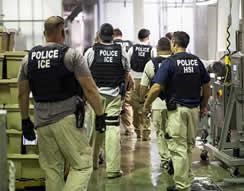It is one of the strangest episodes in American history: a number of cities, and some states, have decided to protect illegal aliens who have committed serious crimes.
A typical example is California, where SB54 made that jurisdiction a “Sanctuary State” in which local law enforcement will not cooperate with the federal government in Washington’s attempt to seize illegal aliens lawbreakers. As then-acting ICE director Tom Homan said at the time of passage (in 2017), “SB54 will negatively impact ICE operations in California by nearly eliminating all cooperation and communication with our law enforcement partners in the state… and prohibiting local law enforcement from contracting with the federal government to house detainees.”
The following year, New York City followed California’s example. h The results, unfortunately, were predictable. According to Scott Mechowski, ICE acting field office director: “In just three months, more than three dozen criminal aliens were released from local custody. Simply put, the politics and rhetoric in this city are putting its own communities at an unnecessary risk.”
The result of this odd experiment in political correctness have now been clearly spelled out in an ICE study. We provide key excerpts:
Immigration, Citizenship, And The Federal Justice System, 1998-2018
This… report highlights trends from 1998 through 2018, providing statistics on immigration and non-immigration offenses, U.S.-Mexico border and non-U.S.-Mexico-border districts, and country of citizenship. The findings are based on data collected by BJS’s Federal Justice Statistics Program (FJSP), which receives administrative data from six federal justice agencies: the U.S. Marshals Service, Drug Enforcement Administration, Executive Office for U.S. Attorneys, Administrative Office of the U.S. Courts, U.S. Sentencing Commission, and Federal Bureau of Prisons. The FJSP links and standardizes this information, enabling the production of statistics not available elsewhere.
Highlights:
Based on fiscal years—
- In 1998, 63% of all federal arrests were of U.S. citizens; in 2018, 64% of all federal arrests were of non-U.S. citizens.
- Non-U.S. citizens, who make up 7% of the U.S. population (per the U.S. Census Bureau for 2017), accounted for 15% of all federal arrests and 15% of prosecutions in U.S. district court for non-immigration crimes in 2018.
- The portion of total federal arrests that took place in the five judicial districts along the U.S.-Mexico border almost doubled from 1998 (33%) to 2018 (65%).
- Ninety-five percent of the increase in federal arrests across 20 years was due to immigration offenses.
- In 2018, 90% of suspects arrested for federal immigration crimes were male; 10% were female.
I n 2018, 64% of all federal arrests were of non-U.S. citizens. In comparison, 37% of all federal arrests in 1998 were of non-U.S. citizens. Federal arrests of non-U.S. citizens more than tripled from 1998 to 2018 (rising 234%), while federal arrests of U.S. citizens rose 10%.
Citizenship: While non-U.S. citizens make up 7% of the U.S. population (per the U.S. Census Bureau for 2017), they accounted for 15% of all federal arrests and 15% of prosecutions in U.S. district court for non-immigration crimes in 2018.
Non-U.S. citizens accounted for 24% of all federal drug arrests and 25% of all federal property arrests, including 28% of all federal fraud arrests.
Citizenship by Country: The country of citizenship of persons arrested by federal law enforcement changed notably over time. From 1998 to 2018, Mexican citizens’ share of federal arrests rose from 28% to 40%. Citizens of Central American countries’ share of federal arrests rose from 1% to 20% during the same period, while U.S. citizens’ share of federal arrests fell from 63% to 36%.
The border and immigration: From 1998 to 2018, the portion of all federal arrests that took place in the five federal judicial districts along the U.S.-Mexico border (out of a total of 94 judicial districts nationwide) almost doubled, increasing from 33% to 65%. In 2018, a quarter of all federal drug arrests took place in these five districts. Across 20 years, 95% of the increase in federal arrests was due to immigration crimes. Federal immigration arrests from 1998 to 2018 increased 5-fold (from 20,942 to 108,667). Prosecutions Of suspects prosecuted in U.S. district court in 2018, 57% were U.S. citizens and 43% were non-U.S. citizens. Almost all (99.7%) of the non-U.S. citizens prosecuted in U.S. district court were prosecuted for something other than first-time illegal entry. The five crime types for which non-U.S. citizens were most likely to be prosecuted in U.S. district court were illegal reentry (72% of prosecutions), drugs (13%), fraud (4.5%), alien smuggling (4%), and misuse of visas (2%)
Photo: ICE
